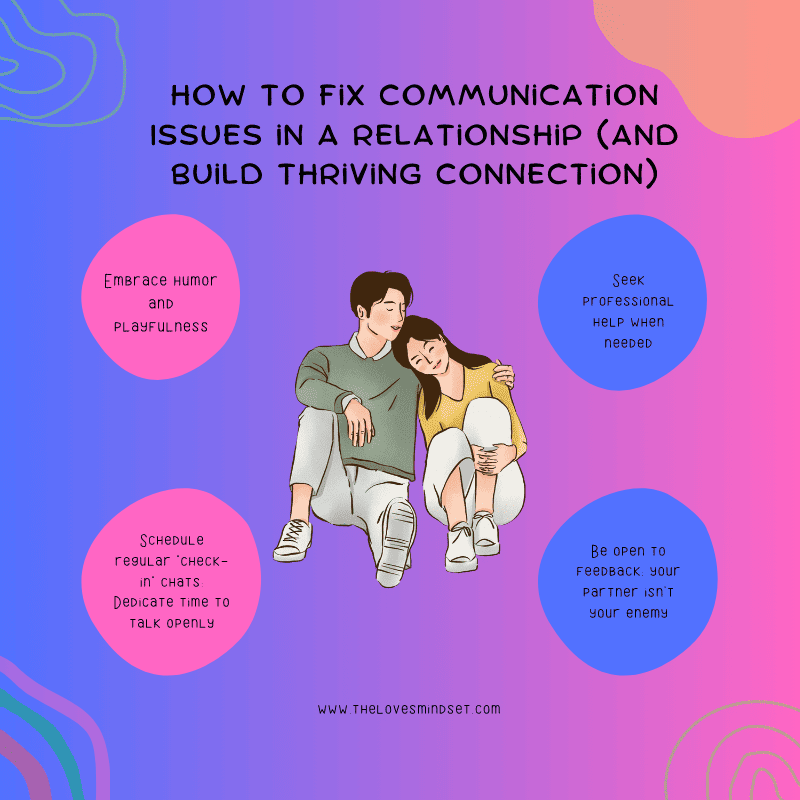Hey, love navigators, welcome back to The Lover’s Mindset! Today, we’re diving headfirst into the often-murky waters of communication. You know, those times when things just seem to get lost in translation, misunderstandings bloom like weeds, and you’re left wondering, “How to fix communication issues in a relationship?“
Don’t worry, you are not alone. Even the strongest connections can stumble over communication hurdles. Misinterpretations sprout like wildfire, frustration takes root, and suddenly that vibrant garden of understanding is replaced by a towering brick wall of disconnection.
But fear not, because just like any garden, relationships need tending, and fixing communication issues in your relationship is a crucial part of that process. So, grab your metaphorical garden shears, put on your listening gloves, and let’s get pruning!
Why Communication Matters: Building Bridges, Not Walls
Before we dig into the weeds, let’s appreciate the magic of healthy communication. It’s the sunshine that nourishes trust, the fertilizer that strengthens intimacy, and the bridge that connects you to your partner’s heart. When communication flows freely, emotions bloom, and problems, well, they don’t disappear, but they become stepping stones, not too overwhelming.
But when communication issues rear their ugly heads, the garden wilts. Misunderstandings suffocate trust, resentment takes root in the shadows, and isolation builds a lonely brick wall around your connection. That’s why learning to fix communication issues in a relationship is a superpower, not just for romantic partnerships, but for any, and all connections in your life.
The Weeds of Communication: Common Culprits
So, what are these dreaded weeds of communication? Let’s identify some common culprits to pull out by the roots:
- The Mind-Reading Monster: This creature whispers insidious doubts, convincing you your partner knows exactly what you’re thinking (and somehow disapproves). But newsflash, love navigators, mind-reading is a party trick, not a relationship skill. Speak about your needs and feelings! Your partner isn’t a psychic waiting to decode your silent thoughts.
- The Blame Game Bandit: This masked villain loves pointing fingers and slinging accusations. But blame breeds defensiveness, not understanding. Shift the focus to “I” statements and shared solutions. Remember, you’re a team, not adversaries in a courtroom drama.
- The Stonewalling Sphinx: This mysterious figure shuts down, building a wall of silence around their emotions. But silence fuels confusion and hurt. Practice expressing your feelings, even if it’s uncomfortable. Vulnerability is the key to connection, not a weakness.
- The Interrupting Imp: This overeager character cuts off their partner mid-sentence, eager to be heard but forgetting to listen. Active listening, and love navigators, are the golden tickets. Give your partner your full attention without interrupting them. Understanding awaits on the other side of silence.
Planting the Seeds of Healthy Communication: Practical Tips
Now, let’s move from identifying weeds to planting the seeds of healthy communication. Here are 5 practical tips to fix communication issues in a relationship and cultivate a blossoming garden of connection:
- Pick Your Time and Place: Don’t launch into a deep conversation when you’re both drained and angry. Choose a calm, distraction-free space where you can give each other your full attention. Remember, even the most important discussion can turn into a shouting match if you’re both fueled by stress and angry rumbles.
- Start with Appreciation: Acknowledge the good things! A simple “I appreciate you doing the dishes” or “I loved that joke you told” softens the ground for more challenging conversations. Let your partner know they’re valued and appreciated, even before you dive into a tricky topic.
- Speak Your Truth – Kindly: Use “I” statements to express your feelings and needs without blaming or attacking. “I feel hurt when you cancel plans last minute” is a lot more productive than “You always let me down!” Remember, kindness is the fertilizer that makes even difficult conversations easier to digest.
- Listen, Really Listen: Put down your phone, make eye contact, and give your partner your full presence. Show them you’re genuinely interested in understanding their perspective. Active listening involves more than just hearing the words; it’s about absorbing the emotions and nuances behind them.
- Validate, Don’t Justify: Acknowledge your partner’s feelings, even if you don’t agree with them. Saying “I understand you’re feeling frustrated” validates their experience without needing to defend themselves. It’s about acknowledging their perspective, not necessarily agreeing with it.
Scenarios & Solutions: Putting Theory into Practice
Okay, the theory about “how to fix communication issues in a relationship” is great, but let’s put it into practice! Let’s tackle some common communication roadblocks with real-life scenarios:
Scenario 1: Your partner constantly criticizes your choices.
Solution: Remember the “I” statements! Instead of escalating with defensiveness, try something like, “I feel hurt when you criticize my job choices. Can we have a conversation about this without judgment?” This opens the door for a calmer discussion about their concerns and your needs.
Scenario 2: Your partner shuts down emotionally and withdraws.
Solution: Give them space but express your concern and willingness to reconnect. Say something like, “I notice you’re pulling away and I want to support you. When you’re ready to talk, I’m here to listen.” Respect their need for space while showing you’re still available and open to communication when they’re ready.
Scenario 3: You feel like your partner isn’t listening to you.
Solution: Gently interrupt the non-listening behavior and reiterate your need to be heard. Say something like, “Excuse me, I feel like I’m not being heard right now. Can we try again when you’re ready to give me your full attention?” This reminds them of your need for active listening without sounding accusatory.
Remember, love navigators, communication isn’t about being perfect, it’s about progress. There will be stumbles, misunderstandings, and moments of frustration. But with patience, practice, and these handy tips, you can fix communication issues in a relationship and transform those brick walls into sturdy bridges of connection.
Beyond the Honeymoon: Keeping the Communication Flower Blooming
Remember, building strong communication isn’t a one-time fix, it’s an ongoing process. Here are some tips for keeping the communication flower blooming, even years down the road:
- Schedule regular “check-in” chats: Dedicate time to talk openly and honestly about your needs, feelings, and relationships. These can be casual or focused on specific topics, but the key is to prioritize regular communication. It’s like watering your garden of connection regularly!
- Embrace humor and playfulness: Don’t let the conversation become a chore! Keep things light, share funny anecdotes, and remind yourselves why you enjoy each other’s company. Laughter and playfulness are like sunshine for your communication garden.
- Be open to feedback: Remember, your partner isn’t your enemy, they’re your teammate. Be open to constructive criticism and feedback, and use it as an opportunity to grow together. Feedback can be fertilizer for your communication garden, helping it grow even stronger.
- Seek professional help when needed: If communication issues feel overwhelming or you’re struggling to make progress, don’t hesitate to seek professional help. A therapist can provide valuable tools and guidance to strengthen your communication skills and overcome communication roadblocks. They can be like expert gardeners, helping you cultivate a thriving communication ecosystem in your relationship.
Conclusion: Building Bridges, Not Walls, One Conversation at a Time
Remember, love navigators, fixing communication issues in a relationship is like building bridges – it takes effort, patience, and a willingness to meet halfway. By nurturing healthy communication through active listening, kind expression, and a genuine desire to understand each other, you can transform your relationship into a thriving ecosystem of love, trust, and joy. So, let’s commit to building bridges, not walls, in all our relationships, starting today.


Leave a Reply